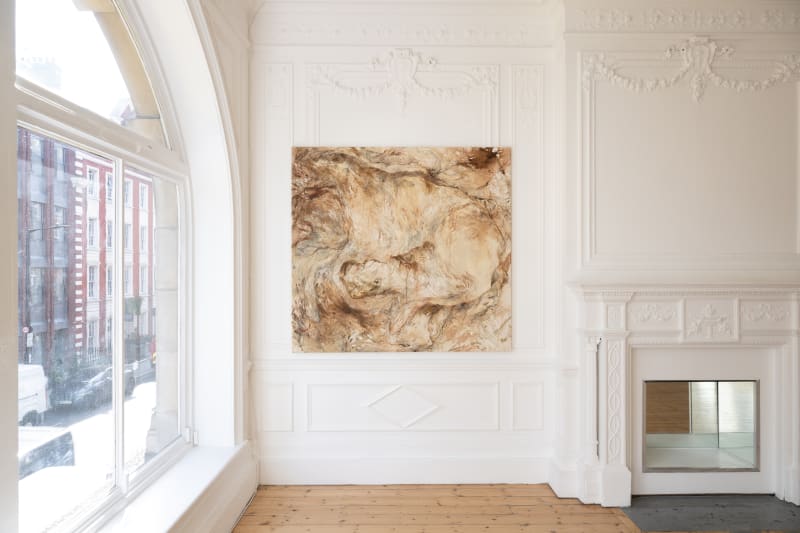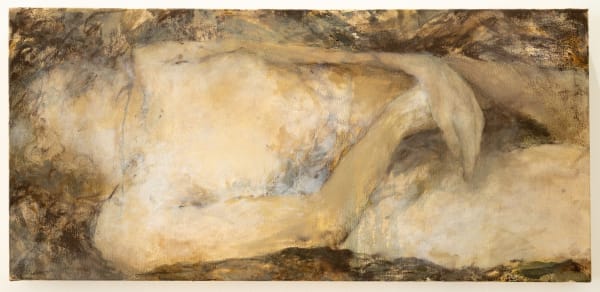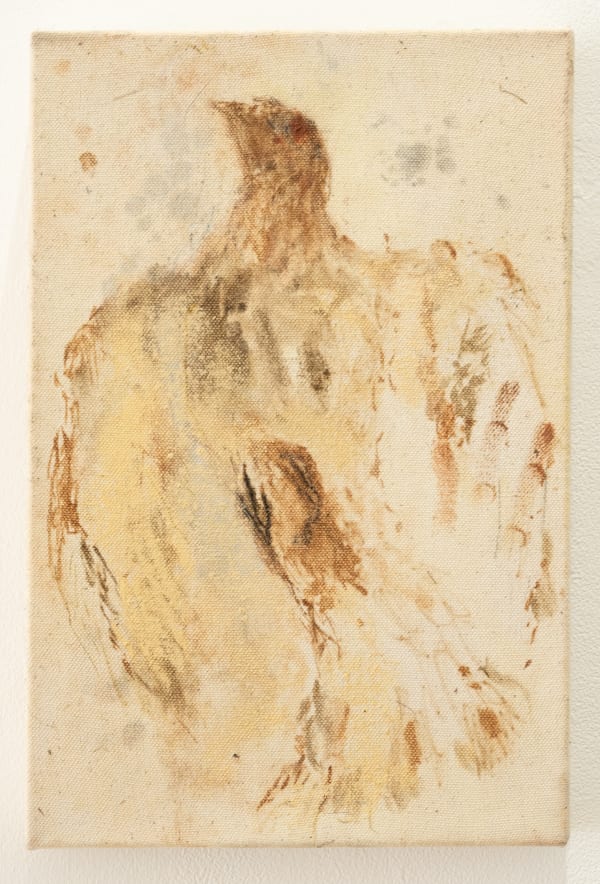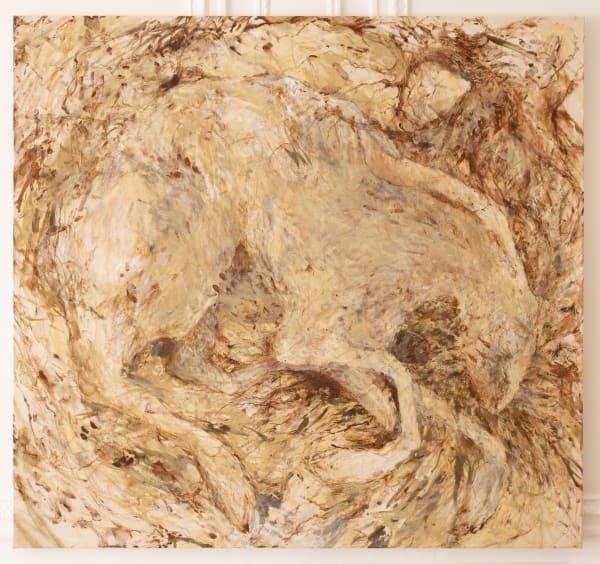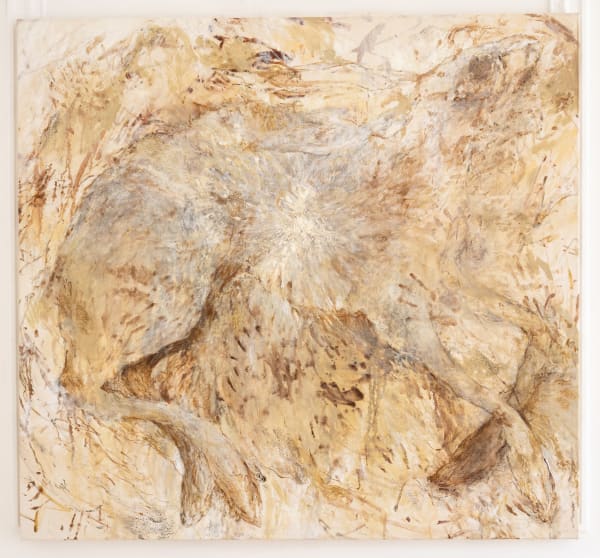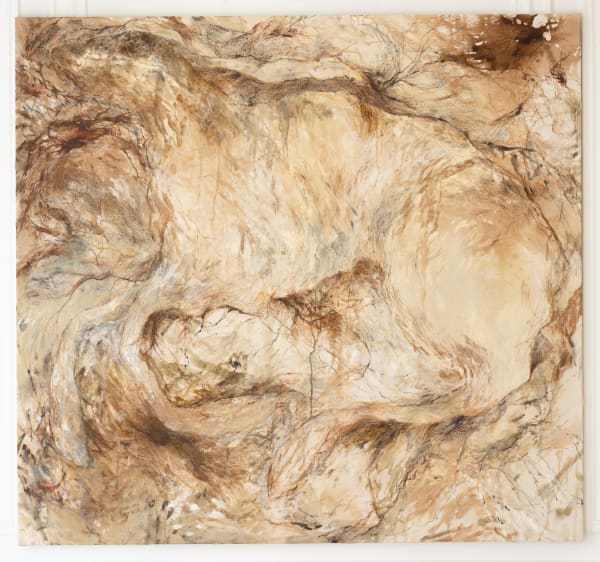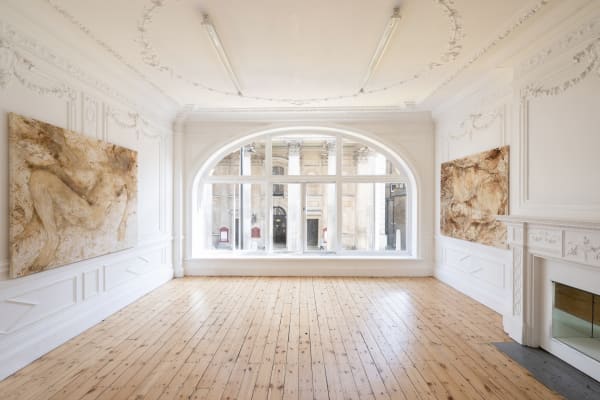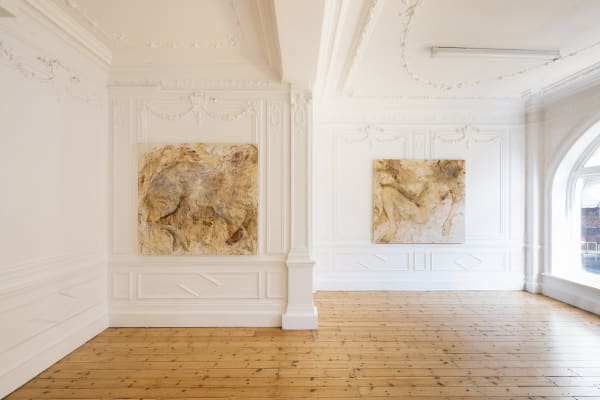Remains: Mia Graham
-
Overview
General Assembly is pleased to present Remains, a solo presentation of new works by Mia Graham. Through three totemic bodies: rabbit, human and bird, Graham invites us to explore an understanding of physical decay and regeneration that she has manifested through painting.
The exhibition is anchored prominently by Shroud, Graham’s largest painting to date. Completed recently, at General Assembly’s Loire Valley summer residency, Graham’s painting took on a life of its own, with Graham surrendering her own will, tapping into a deeper, more intuitive creative space. In this environment Graham submitted to her own corporeal presence, using her hands to mark the canvas; and to that of the surrounding nature, embracing leaf traces on the work. The result rejects sterility, and celebrates a deeper freedom, where the work is encompasses a materiality of disintegration.
In Shroud, the artist renders a woman with delicate physicality and lightness of body, her left hand seems to clasp a bird which lies, unmoving, next to her. Marked with prints of the artist’s own hand, the work is simultaneously monumental and intimate. Graham’s depicts the female figure in an ambiguous state of repose. She leads us to question - Is she sleeping? Daydreaming? Or perhaps the form we are viewing is merely a remnant of her existence. The figure exists within this tension, and Graham invites the viewers to draw their own conclusions.
This tension is also found in the Remains series of rabbits. Where Graham takes inspiration from British folklore, and a personal connection to the physicality of the animals. The rabbits are depicted as creatures that occupy both the terrestrial world and a deeper netherworld. They can frolic in the grass and burrow into the earth deep beneath it as if moving through levels of consciousness. Similarly to Graham’s human figures, the rabbits are able to traverse multiple planes of existence with ease. Unlike the figure in Shroud, however, the rabbits in the Remains series are dead. For Graham, the question is what becomes of the twitching energy that once pulsated through them? What Remains of them?
Unlike a perished rabbit, a dead pigeon is a presence of death one might happen upon in day to day city life. These chance encounters Graham uses to observe real-life manifestations of her thoughts and ideas, out of which her ongoing bird series is born. The artist studies the birds and their bodies as they begin to decompose; she is fascinated by their unceremonious state of burial, laying exposed on street corners and roadsides. In these moments Graham seeks to exalt the discarded birds, and absorb a visual essence of the material regeneration that has begun.
Despite Graham’s curiosity surrounding death, the works do not have a morbid quality. They are imbued not with a fear of death, but with an understanding that it is part of life’s cyclical nature; a point within a larger continuum. Taken together, the works in Remains depict a series of transitional moments, a woman sliding into a dreamstate, the flesh of a rabbit returning to the earth, the fragile body of a bird in its final resting place. It is these moments between physical or psychological states, where Graham seeks truth.
-
-
Installation Shots
-
DOSSIER

The Remains series was born in the Loire Valley of France during the summer of 2024. Shroud, the seminal work of the series, is inherently located in the historically rich Loire. Mia Graham (b. 2000), a participant of General Assembly’s summer residency programme, paints between the boundaries of abstraction and figuration. A central figure reclines diagonally across the composition. The identity of the figure is obscured by a veil of mottled paint; underneath the left hand rests a bird, with its feet drawn back against its body. While it is uncertain whether the subjects are living or dead, there is an undeniable sense of vigor in the painting.
Shroud exhibits the intense physicality of Graham’s painting process. Graham’s use of hand and fingerprints to apply paint to the canvas is visible across the entire painting. In some cases, the application of paint with her hands builds a patina on the support. This textural element emphasizes the presence of the artist in the painting. Beneath these prints brush marks and paint drips form the foundation of the composition. Graham is consistent throughout the Remains series; Remains 3 offers a particularly strong parallel for comparison of Graham’s painterly style. While the subject of Remains 3 differs greatly, Graham’s application of paint is impressively varied. Graham similarly utilized her hands and brushwork for the composition with the addition of dripped paint throughout.
Graham’s use of a purposefully limited color palette further locates the works to the Loire. Located near the residency is the Church of St. Martin, a Romanesque church dating to the 13th century complete with 12th century murals in the nave, apse, and choir. These ancient paintings served as inspiration for Graham during her residency; their impact is immediately evident in the Remains series. Graham’s ochre, black, red, and brown paints encourage a dialogue between her contemporary practice and the 12th century paintings which she studied. An intense sense of spirituality emanates from Shroud; Graham spoke to her own upbringing and the presence of religion in her early life when discussing the Remains series. While the works do not connote Christian iconography, they do emphasise the spiritual significance of totemic figures (the rabbit, human, and bird) in Graham’s practice. Also influential for Graham is the poetry of William Blake, whose poem ‘Auguries of Innocence’ continues to intrigue Graham. Blake’s description of Nature feels “resonant and inspirational” for Graham, adding a literary element to the themes which she continues to investigate through her paintings.
No two works in the Remains series are the same. Neither, then, are the reactions to any two paintings the same. Graham’s presentation of rabbits, people, and birds encourages a reflection on decay, life lived, and the presence of the physical body in the material world. Graham participates in this reflection; there is no attempt to sway the audience in favor of one interpretation or another. Instead, Graham paints with respect for mortality and lived experience. Through her passionate application of paint Graham offers tools to comprehend the many journeys which cross through all manner of lives.
